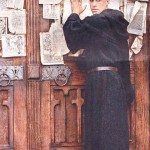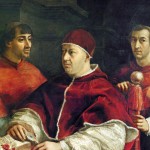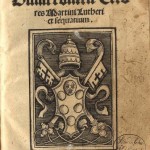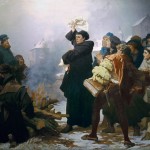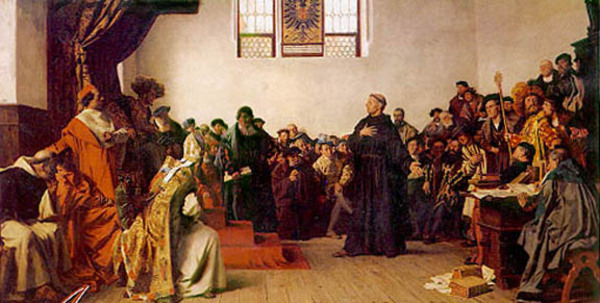Martin Luther 1483 – 1546
[gview file=”http://www.historyvault.ie/wp-content/uploads/2014/05/Martin-Luther-Religious-Reformer-during-the-Reformation.doc”]
(1483 – 1546)
by Mohammed Jaber (2A), 15th April 2011
Introduction
In Europe in the sixteenth century, a lot of religious changes occurred. These changes occurred because the Christian church was making up laws that were not in the Bible, e.g. priests were selling indulgences. These were supposed to reduce the punishment for sins after a person died. There were also many abuses within the Christian church, e.g. nepotism (appointing a relative to an important position more than one position in the church) and absenteeism (bishops and priests not living in their dioceses or parishes). In 1517, a German monk called Martin Luther attacked the sale of indulgences.
Early life
Martin Luther was born in Eisleben in Saxony, Germany in 1483. At school he was a good student and his father wanted him to be a lawyer. He studied law at Erfurt University but when he was caught in a thunder storm he promised to god that if he survived he would become a monk and he did survive. Luther now started to study theology in 1505. In 1512 Luther became a professor of theology in a new university founded by Frederick the Wise (ruler of Saxony) called the University of Wittenberg.
‘Justification by faith alone’
Martin Luther read the Bible over and over again and became convinced that the churches teaching of how to get into heaven was wrong. The church said that a mixture of faith and good works were needed to get into heaven. Luther now started to believe that faith alone will get you into heaven. This was called ‘justification by faith alone’.
The 95 Theses
At the time, Pope Leo X was collecting indulgences’ money to pay for the rebuilding of the St. Peter’s Basilica in Rome. The Pope’s commissioned friar, John Tetzel, sold indulgences around Wittenberg. Luther did not like this because he thought that people thought that they could buy their way into heaven by buying indulgences. The 95 Theses is a list of everything wrong with the Christian church which was written by Luther. On the 31st of October 1517 Luther nailed this list on the church door of Wittenberg.
- Pope Leo X
- Exsurge Domine
- Luther burning the Papal Bull
Pope Leo X
Pope Leo X was the pope of the Roman Empire in the sixteenth century. He was outraged by Luther’s actions and he wanted him to go to Rome to be investigated. Frederick the wise made sure that Luther would not go to Rome because he was proud that a professor out of his new university had become famous. The Pope reacted by sending Luther a Papal Bull (a letter from the pope) called ‘Exsurge Domine’ telling Luther to take back his teachings within 60 days or he will be excommunicated (thrown out of the church). The church also burnt some of Luther’s books/pamphlets so in revenge Luther burnt the papal bull in public.
Diet of Worms
The pope asked the new elected holy Roman emperor Charles V to deal with Luther but he had to be careful because one of the rulers who elected him was Frederick the Wise. Charles did not want to annoy Frederick so he invited Luther to the diet of Worms. A diet is a meeting for all the German princes. Worms is where it was held at. At the diet Luther said all his beliefs and then was condemned as a heretic and an out law. This meant that anyone could kill him without being arrested. Charles V gave Luther a safe journey to and from Worms.
Frederick the Wise
After Luther came back from Worms, Frederick the Wise kidnapped him and put him in a remote castle until matters calmed down. There, Luther translated the New Testament into German. Later on he translated the Old Testament into German.
Luther’s Ideas Spread
Many people started to leave the Christian church and follow Luther. These people were known as Lutherans. In 1529, Emperor Charles V tried to ban Luther’s ideas. A number of princes started to protest so the religion became known as Protestantism and its followers became known as Protestants. Luther’s ideas spread to northern Germany, Denmark, Sweden and Norway.
Religious Divisions erupt within the Holy Roman Empire
A war broke out between Protestants and Catholics over some German Princes protesting against the suppression of Luther’s ideas. These princes were first dubbed ‘Protestants’. It ended in 1555 with the Peace of Augsburg. This treaty declared that the ruler of a state would decide the religion of his own state.
Luther’s later life
In 1525, Luther got married to a former nun Catherine Von Bora. Their marriage was very happy with six children. He was not a rich man and rented rooms in his house to students. In 1546, Luther died of a heart attack at his birthplace of Eisleben.
Why Luther’s ideas succeeded:
-
He was helped by the newly invented printing press which meant that his ideas could spread easier.
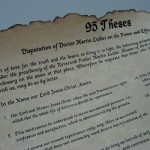
- Luther was good at speeches and at getting his message across.
- He was supported by a German prince, Fredrick the Wise.
Luther’s main ideas:
- Bible is the source of all teachings.
- Faith alone got you into heaven.
- The church is controlled by the prince.
- Communion services are said in German.
- Only 2 sacraments: Baptism and Eucharist.
- All Protestants are equal and should be able to read the Bible.
- Priests are allowed to marry.
Europe after the Reformation
RED: Lutherans
YELLOW: Roman Catholic
GREEN: Calvinist (John Calvin: another reformer)
PURPLE: Anglican (Church of England)
BROWN: Muslim
Written, researched & compiled by Mohammed Jaber (2A), 15th April 2011


